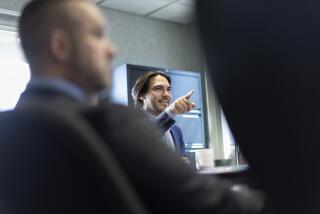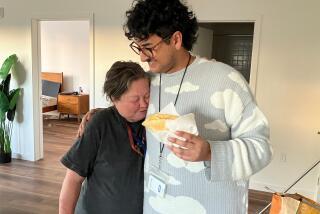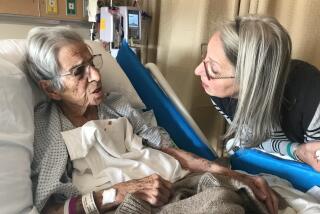The Comforts of Home
Facing terminal cancer is devastating enough without having to worry about how to get to a chemotherapy session or who will feed the dog. It was just such matters that concerned Barbara Browning in 1978, when, as head oncology nurse at Santa Monica Hospital, she would receive phone calls from frustrated patients trying to cope after they returned home from the hospital.
Wanting to find a way to help, Browning sought counsel from her pastor, the Rev. Robert S. Richards of the Lutheran Church of the Master in West Los Angeles. He conceived the idea of a volunteer group that would provide practical services for patients in their last months. After four years of raising funds, dealing with the legal requirements of nonprofit incorporation and recruiting volunteers, the nonsectarian Hospice in Home program began aiding its first patients in 1982.
Browning, who is now associate director of organizational improvement at the hospital, now Santa Monica-UCLA Medical Center, devotes several hours a week to the enterprise. She matches volunteers and patients, serves patients of her own, obtains needed equipment such as wheelchairs and, with Richards, fields phone calls from family members wanting to know how to deal with ill loved ones or needing referrals to various resources.
“We call what the volunteers do ‘active helplessness,’ ” says Browning, 51, who spent 15 years as an oncology nurse and moved to administration in 1990. “You can’t cure the cancer. You can’t stop the dying. But you’re there, active in your helplessness, to support the person. You can give the patient and family hope--not to get well, but to be comfortable, maybe, or to eat without throwing up, which are small-term hopes.”
The only hands-on care volunteers provide is turning a patient in bed; they are there, free of charge, for companionship and to fulfill such needs as transportation, grocery shopping, obtaining medical supplies and pet feeding. Volunteers and patients are paired on the basis of personality, location and specific needs.
Volunteers, who work five to 15 hours per week, run the gamut from physicians and nurses to teachers, homemakers and business people. “We had a hairdresser who went to people’s homes and did their hair, and a doctor who was also a handyman and put up hand-rails,” Browning recalls. The program serves an average of five to 10 patients at any given time, though the tally has occasionally risen to 20.
Having someone on hand to take care of day-to-day details can make the difference between dying at home or in a less personal setting. “Dying in your own bed, in your own surroundings, is more comfortable,” Browning says. “When you’re sad, need support, when you’re hurting, you want to be comfortable, and for most of us, that’s home. It’s a safe place, often with good memories. You look around and see things that are yours. Even having your own sheets can be important.”
The volunteers also represent a link to the outside world, says Richards. “A lot of people are really alone. And in the days when we started Hospice in Home, cancer victims were regarded as if they had leprosy--people didn’t want to be around them.” The program affords those who are ill a measure of respect, he adds. “We don’t deal with ‘patients.’ The volunteers and the people are all ‘members of hospice.’ We like to see it as a covenant relationship of equals. The person who is dying is equal to the person serving them.”
*
One who has served since the program’s inception is Santa Monica resident Mary Fugard, whose late husband was also a volunteer. “It’s very rewarding,” she says. “I still keep in touch with many of the family members--one man’s daughter is getting married soon and sent me an invitation. I’ve taken people to chemotherapy and radiation, and given respite care to the caregiver.
“With some patients, it’s just visiting. To be lying flat on your back 24 hours a day can’t be a lot of fun. We talk, reminisce a little bit, and the time passes quickly. My husband, Bill, once had a testy, salty old goat, a recluse. Bill talked him into getting hearing aids, and he blossomed after that.”
In one case, Fugard became close to both a cancer patient who died in 1982, and his wife, continuing to have lunch and attend movies with the widow until her death in February. Says the couple’s daughter-in-law, Beverly Mowry, “Mary was a big help to my mother-in-law after my father-in-law died. She never did it out of a sense of duty. She genuinely wanted to.”
Browning, too, focuses on the rewards of her work. “Death is the ultimate in healing,” she says. “If you see a person writhing in pain, throwing up, is that better? When death comes, it’s often a relief. I get a lot of satisfaction supporting people when they’re dying. It’s not depressing. It’s very special to be with someone when they die. It’s a privilege.”
* This occasional column tells the stories of the unsung heroes of Southern California, people of all ages and vocations and avocations, whose dedication as volunteers or on the job makes life better for the people they encounter. Reader suggestions are welcome and may be sent to Local Hero Editor, Life & Style, Los Angeles Times, Times Mirror Square, Los Angeles 90053.
More to Read
Sign up for The Wild
We’ll help you find the best places to hike, bike and run, as well as the perfect silent spots for meditation and yoga.
You may occasionally receive promotional content from the Los Angeles Times.






